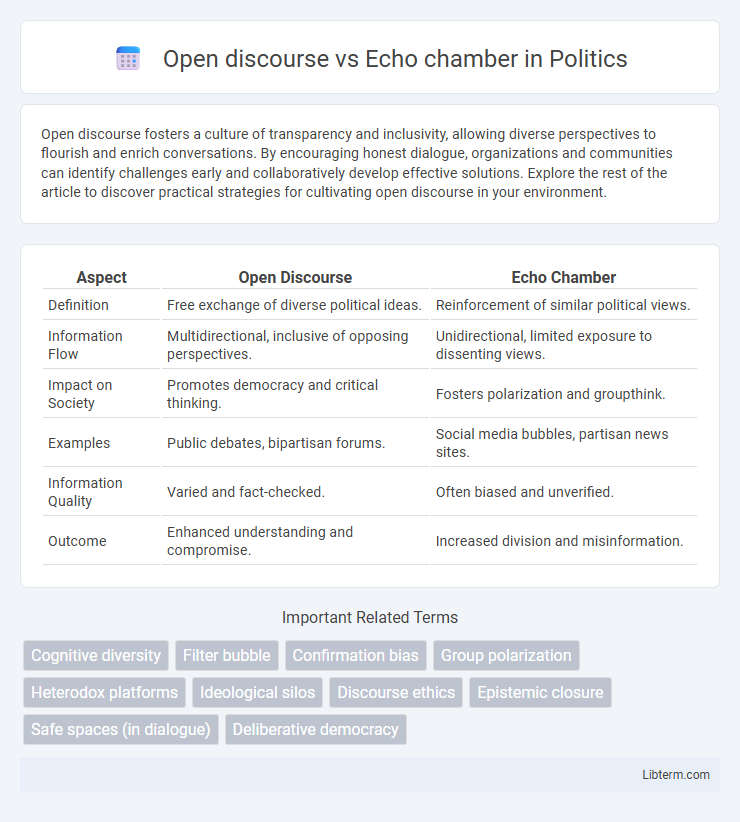Open discourse fosters a culture of transparency and inclusivity, allowing diverse perspectives to flourish and enrich conversations. By encouraging honest dialogue, organizations and communities can identify challenges early and collaboratively develop effective solutions. Explore the rest of the article to discover practical strategies for cultivating open discourse in your environment.
Table of Comparison
| Aspect | Open Discourse | Echo Chamber |
|---|---|---|
| Definition | Free exchange of diverse political ideas. | Reinforcement of similar political views. |
| Information Flow | Multidirectional, inclusive of opposing perspectives. | Unidirectional, limited exposure to dissenting views. |
| Impact on Society | Promotes democracy and critical thinking. | Fosters polarization and groupthink. |
| Examples | Public debates, bipartisan forums. | Social media bubbles, partisan news sites. |
| Information Quality | Varied and fact-checked. | Often biased and unverified. |
| Outcome | Enhanced understanding and compromise. | Increased division and misinformation. |
Understanding Open Discourse
Open discourse fosters diverse perspectives and critical thinking by encouraging the free exchange of ideas without censorship or bias. It thrives in environments where individuals can challenge assumptions and engage in constructive debate, enhancing collective knowledge and innovation. Understanding open discourse involves recognizing its role in breaking down misconceptions and preventing the homogenization of thought that characterizes echo chambers.
What Defines an Echo Chamber?
An echo chamber is defined by the reinforcement of shared beliefs through repetitive communication within a closed community, limiting exposure to opposing viewpoints. It promotes selective information filtering where dissenting opinions are excluded or discredited, fostering intellectual homogeneity and confirmation bias. This contrasts with open discourse, which encourages diverse perspectives, critical thinking, and constructive debate to enhance understanding and innovation.
Key Differences Between Open Discourse and Echo Chambers
Open discourse fosters a diverse exchange of ideas, encouraging critical thinking and exposure to multiple perspectives, while echo chambers reinforce existing beliefs by limiting information to homogeneous viewpoints. In open discourse, participants engage in respectful debates and consider evidence-based arguments, whereas echo chambers often rely on selective exposure and confirmation bias, leading to intellectual isolation. The key difference lies in the openness to dissenting opinions: open discourse promotes dialogue and growth, whereas echo chambers amplify conformity and polarization.
The Benefits of Open Discourse
Open discourse fosters diverse viewpoints, promoting critical thinking and innovation by exposing individuals to new ideas and constructive debates. This exchange of perspectives enhances problem-solving skills and strengthens democratic processes through informed decision-making. Embracing open discourse helps break cognitive biases inherent in echo chambers, leading to more inclusive, balanced, and effective communication.
Risks and Consequences of Echo Chambers
Echo chambers limit exposure to diverse perspectives by reinforcing preexisting beliefs, which can intensify polarization and hinder critical thinking. This insular environment fosters misinformation, reduces empathy for opposing views, and undermines democratic discourse. Prolonged engagement in echo chambers may lead to social fragmentation and decreased capacity for meaningful dialogue across ideological divides.
Psychological Factors Behind Echo Chambers
Echo chambers are reinforced by psychological factors such as confirmation bias, where individuals favor information that aligns with their existing beliefs, and social identity theory, which drives people to conform to group norms for acceptance. These cognitive biases reduce exposure to diverse perspectives, limiting critical thinking and increasing polarization. In contrast, open discourse encourages cognitive flexibility and exposure to conflicting viewpoints, fostering a more balanced and nuanced understanding of complex issues.
The Role of Social Media Platforms
Social media platforms serve as pivotal arenas for both open discourse and echo chambers by shaping the flow of information and interaction patterns. Algorithms prioritize content aligned with users' preferences, often reinforcing existing beliefs and facilitating echo chambers that limit exposure to diverse perspectives. However, these platforms also offer tools for broadening dialogue, enabling users to engage with varied viewpoints and fostering more inclusive and dynamic discussions.
Breaking Free from Echo Chambers
Breaking free from echo chambers requires actively seeking diverse perspectives and engaging with contradictory viewpoints to foster open discourse. Exposure to a wide range of information sources and critical thinking helps dismantle confirmation bias and promotes intellectual growth. Encouraging respectful dialogue across different opinions cultivates understanding and mitigates polarization in social and digital environments.
Fostering a Culture of Open Dialogue
Fostering a culture of open dialogue requires actively promoting diverse perspectives and critical thinking to counteract the homogeneity of echo chambers. Implementing practices such as inclusive conversations, respectful debate, and exposure to varied viewpoints enhances collective understanding and innovation. Emphasizing transparency and empathy in communication strengthens trust and encourages participants to engage openly without fear of judgment.
Open Discourse: Pathway to Innovation and Progress
Open discourse fosters diverse perspectives and critical thinking, enabling innovation by challenging established ideas and promoting creative solutions. It creates an inclusive environment where constructive debate drives progress and adapts to emerging challenges. This dynamic exchange of ideas contrasts with echo chambers, which limit growth by reinforcing existing beliefs and stifling innovation.
Open discourse Infographic

 libterm.com
libterm.com